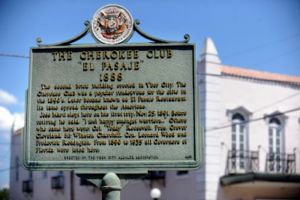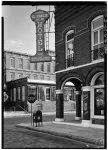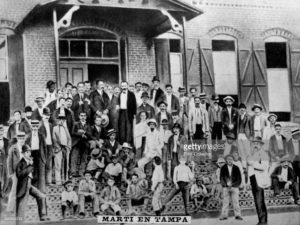
As I mentioned in my previous blog article, last summer I had the opportunity to visit the beautiful island of Cuba. At the time, I didn’t realize how fortunate I was since travel has now recently been rescinded. In my opinion, that’s a shame. I do understand it’s a political decision although I do not agree that we should not be on speaking terms with a neighbor. Cuba is only 90 miles from our nation and populated with people who are family to many of our citizens. Genealogywise, this separation saddens me.
I have not previously blogged about my trip because it was for pleasure only. I longed to go there since I was three years old; my parents used to watch I Love Lucy and although Lucy’s fake crying set me off, I was enchanted with Desi’s accent and musical skills. My mother told me he was from Cuba and in my preschool mind, everyone on the island – an island, no less – now that added to the mystique! – was as talented as Desi. Someday, I was sure to visit.
Unfortunately, as I grew up, our countries grew apart. Sure, I spent every Wednesday at 10 AM hiding under my desk at school under the false pretense of being protected from a nuclear blast that was certain to hit the Chicago area from the disagreement but I still longed to go there. (As a side note, I realized how stupid the idea of these drills were one June morning after school had just closed for the summer. I was sitting on the back porch swing of my grandparent’s home reading a Nancy Drew mystery when the air raid siren blasted. On that beautiful late spring day it occurred to me that if a real nuclear event happened, I’d not likely have the protection of my school desk. I only lived one block from my elementary school, I could even see my first grade classroom’s windows from my bedroom, and I felt quite safe on the swing at home. I went inside and asked my grandmother what she did when the siren went off and she said she ignored it. My immigrant grandmother was a wise woman and I decided she was correct; hiding under a desk wasn’t going to spare my life. That was the day I started questioning authority.)
Fast forward to last year when a family member decided to take a continuing education course on a cruise ship sailing from my area. I eagerly agreed to go even though we’d only be in the city of Havana for about 8 hours. I scheduled an almost all-day tour for several reasons; the primary being I wanted to hear about the island from a native’s standpoint and not from my country’s. I also knew that like other Caribbean nations, Cuba operates on its own time so if I wanted to go to the fort, for example, it might just be closed at the time of my arrival even though it’s supposed to be open. (You live in Florida long enough and you get used to this concept but I understand it’s maddening if you aren’t used to it.) I figured a tour group would know what was open so I didn’t waste time. I also wanted to insure safety as my Spanish stinks and I’ve been known to say things that was not what I intended. I definitely did not want to be an ugly American.
I’m going to spare you my travelogue of that day and get to why I’m writing about Cuba now – this is what you need to know if you are of Cuban ancestry and unfortunately, didn’t go when you could to research your family. Although it will be more difficult now, it’s still doable with some work arounds.
Do not beat yourself up because you missed the chance. I once had lunch with a Russian genealogist who told me he had difficulty obtaining records back when his country was an ally. One morning on a visit to an archive he was told the records he sought weren’t available. He told a Cuban colleague and later that day, the colleague went to the same repository and came out with the records the Russian had requested. If you’ve been into genealogy for any length of time you probably had a similar situation like this happen to you. Get a different government employee and you get a different answer. Sure, prejudice could have been involved but I’m sticking to the first scenario as it’s happened to me.
I am no expert in Cuban genealogy although living in my area, I have friends and colleagues of Cuban descent who have shared how they have gotten the information they needed. My visit confirmed what they have told me. Here’s my advice, which is mostly commonsense genealogy practices:
· Make sure you get all the information you can about your ancestors’ FULL names and location before beginning so you aren’t contacting the wrong archives and wasting time. By full name, I mean the hyphenated Hispanic name. You don’t have to have the complete name but the more you have the better. (For example, Pablo Picasso’s complete name was Pablo Diego Jose Francisco de Paula Juan Nepomuceno Maria de los Remedios Cipriano de la Santisima Trinidad Ruiz y Picasso. If you only had Pablo Ruiz y Picasso that’s fine).
· If you don’t write well in Spanish, hire a translator. Although most people I encountered spoke English well, that doesn’t mean they read it well so you’ll increase your chances of getting the information you request by clearly communicating in their first language. Don’t rely on online translators; you want to be clear in the Cuban dialect so hire someone.
· Be patient, like I said earlier, Caribbean time is not the same as U.S. time so you may have to wait a LONG TIME for a response. Include a self-addressed stamped envelope to increase your chances of success. How long will you wait? According to my guide, months. This was regarding my question about obtaining cemetery records to the main cemetery in Havana pictured above. As it is still being used, going through old records is not considered important and the request will be filled when burials slow down. No telling when that would be; there was funeral mass in the chapel when we were visiting. (Here’s another aside – if you’ve been following me for years and realize that every time I go on vacation I end up at a cemetery you are correct. I can’t explain it – I just do!)
· It is not recommendable to go online and hire a genealogist. First, there isn’t a lot of trust between our countries which filters down to individual interactions. There is also the economic impact of the most recent decision that clouds the situation. Looking at the list on the Association of Professional Genealogists you will not find one genealogist who resides in Cuba so I advise you to not find someone online who says they’re going to help you. If you have no family members in Cuba you can contact to go and obtain the document you seek, contact the CubanGenealogy Club of Miami who can guide you. (I have attended one of their workshops and was impressed)
· Be prepared to be disappointed as most buildings in the country are not air conditioned so time, humidity, and flooding are just some of the issues that affect the document’s condition, especially in the rural areas. It would have been nice if the Vatican had copies of the church records, since the country was predominantly Roman Catholic but that’s not the case. (Come to think of it, it would have been nice if the Vatican had copies of my needed Croatian records that aren’t on Familysearch so know this isn’t just a Cuban records problem.)
· IMPORTANT CAVEAT – don’t bother trying to get property records. Why? My guide mentioned that there was a concern that Americans were going to try to reclaim the property that their ancestors left behind. I assured her that was not what was the motive is in obtaining property records from a genealogical standpoint. My family member had witnessed this comment and reminded me last month that one of the new U.S. decisions was to support reclaiming property. Personally, I just don’t understand that – I’ve got family that fled lots of wars and rebellions across the globe and I’d never go after their former farms and homes. If a dear reader would like to help me understand the logic in suing for what was abandoned, please comment. I see this as the large impediment of obtaining genealogical records.
If the recommendations above are overwhelming, realize the information you seek may not even be available in Cuba. Cuba was a Spanish colony until 1898 so you’re only looking for Cuban records between 1898 and whenever your family arrived in the U.S. Many of the Spanish records are in Spain. Personally, I’d start there.



